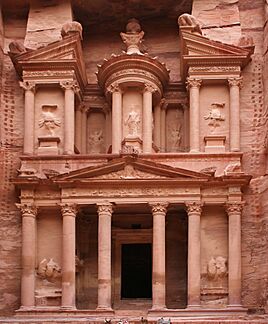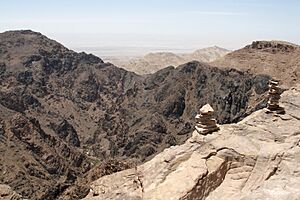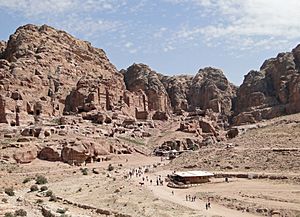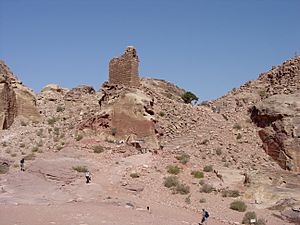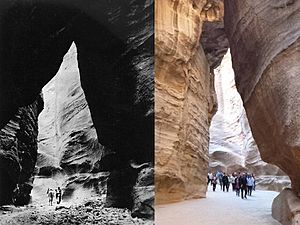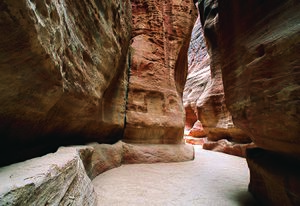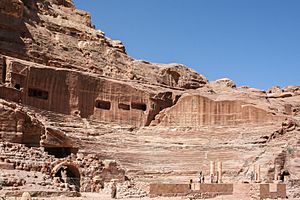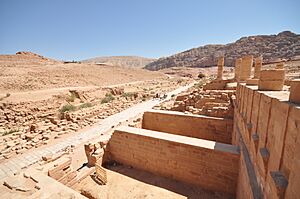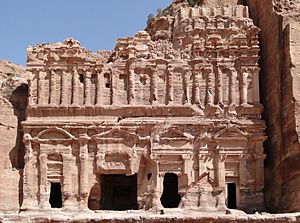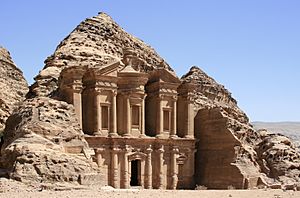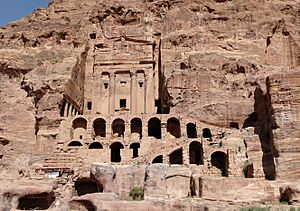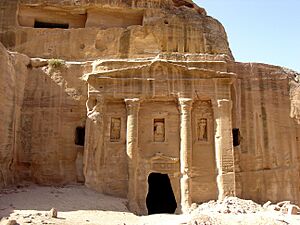Petra facts for kids
Quick facts for kids Petra (𐢛𐢚𐢓𐢈) |
|
|---|---|
|
|
|
| Location | Ma'an Governorate, Jordan |
| Area | 264 km2 (102 sq mi) |
| Elevation | 810 m (2,657 ft) |
| Built | Possibly as early as the 5th century BC |
| Visitors | 1,135,300 (in 2019) |
| Governing body | Petra Region Authority |
| Lua error in Module:Location_map at line 420: attempt to index field 'wikibase' (a nil value). | |
| UNESCO World Heritage Site | |
| Criteria | Cultural: i, iii, iv |
| Inscription | 1985 (9th Session) |
| Area | 26,171 ha |
Petra is an amazing ancient city in southern Jordan. Its original name was Raqmu, given by its first inhabitants, the Nabataeans. Petra is famous for its buildings carved right into the rock. It's often called the "Rose City" because of the beautiful pink color of the sandstone cliffs.
This incredible city is one of the New 7 Wonders of the World. It is also a UNESCO World Heritage Site, meaning it's a very important place for everyone to protect. People have lived in the Petra area since about 7000 BC. The Nabataeans, an ancient Arab people, settled here in the 4th century BC.
Petra became the capital city of the Nabataean Kingdom around the 2nd century BC. The Nabataeans were smart traders. They used Petra's location on the incense trade routes to become a major trading center. This brought them a lot of wealth. They were also very skilled in farming, stone carving, and collecting rainwater.
Petra was at its busiest in the 1st century AD. This is when the famous Al-Khazneh (Treasury) building was made. It might have been a tomb for King Aretas IV. At its peak, about 20,000 people lived in Petra.
The Romans took over Nabataea in 106 AD. They renamed it Arabia Petraea. Petra's importance slowly faded as new sea trade routes became popular. A big earthquake in 363 also damaged many buildings. During the Byzantine era, some Christian churches were built. But the city kept shrinking. By the early Islamic era, most people had left. Petra was mostly forgotten by the Western world until 1812. That's when a Swiss traveler named Johann Ludwig Burckhardt rediscovered it.
Today, Petra is a symbol of Jordan. It's also Jordan's most popular tourist spot. Over a million visitors come to see its wonders every year.
Contents
Discovering Petra's Past
Early Settlements: From Stone Age to Iron Age
The area around Petra has a very long history. Around 7000 BC, some of the first farmers lived in Beidha. This ancient village is just north of Petra.
Later, during the Bronze Age, Petra was mentioned in ancient Egyptian writings. It was called Pel, Sela, or Seir.
During the Iron Age (1200 to 600 BC), the Edomites lived in the Petra area. The mountains around Petra helped them collect water. This made Petra a great place for traders to stop. They traded things like wines, olive oil, and wood. The Edomites left their mark on Petra before the Nabataeans arrived.
The Rise of the Nabataeans
The Nabataeans were a nomadic Arab tribe. They moved with their animals to find water and food in the Arabian Desert. They were very good at living in the desert. This helped them protect their kingdom from enemies.
The Nabataeans named Petra Raqēmō. This name might come from an Arabic word meaning "to mark" or "to decorate." This makes sense because of Petra's famous carved rock buildings.
An ancient historian named Josephus wrote about Petra. He said that in his time, Arabs still called the city Rekeme. This was after its royal founder.
Petra Under Roman Rule
In 106 AD, the Romans took control of the Nabataean kingdom. Petra became the capital of a new Roman province called Arabia Petraea. The city continued to thrive under Roman rule for a while. The Romans even built a road there.
However, Petra's importance began to decline. Another city called Palmyra grew and took away some of Petra's trade. An earthquake in 363 AD also caused a lot of damage. It broke many buildings and the city's important water system.
During the Byzantine period, several Christian churches were built in Petra. But the city kept shrinking. By the early Islamic era, most people had left Petra. Only a few nomads remained.
Petra's Rediscovery
In the 12th century, Crusaders built castles near Petra, like the Alwaeira Castle. But they eventually left. Petra then became unknown to the Western world for many centuries.
In 1812, a Swiss traveler named Johann Ludwig Burckhardt rediscovered Petra. He was exploring the region and heard stories of a "lost city." He dressed as a local and pretended to be on a pilgrimage. This allowed him to enter the hidden city. He was the first European to describe Petra in detail.
Later, in 1828, Léon de Laborde and Louis-Maurice-Adolphe Linant de Bellefonds made the first accurate drawings of Petra. Artists like David Roberts and Frederic Edwin Church also visited and painted Petra, sharing its beauty with the world.
Modern Times in Petra
Over time, many of Petra's ancient tombs were damaged or robbed. In 1929, a team of archaeologists began to study and protect the site.
The local Bedouin people, called the Bedul, used to live in the caves of Petra. In the 1980s, the Jordanian government helped them move to a new village nearby called Umm Sayhoun. This was done to help protect Petra and support tourism. Today, many Bedul work in tourism, sharing their heritage with visitors.
In 1993, ancient scrolls written in Greek were found in a church in Petra. These scrolls tell us more about life in the city during the Byzantine period. More recently, in 2022, Petra experienced heavy flooding, reminding us of the challenges of preserving this ancient site.
Exploring Petra's Layout
Petra is located in a basin surrounded by mountains. These mountains form the eastern side of the Arabah valley. This valley stretches from the Dead Sea to the Gulf of Aqaba.
The Nabataeans were masters of water management. They built dams, cisterns, and water channels. This allowed them to control flash floods and store water. This ability to control water turned Petra into an artificial oasis in the desert. It helped the city grow rich by selling water.
Most visitors today enter Petra from the east. They walk through a dark, narrow gorge called the Siq. This natural crack in the sandstone rocks is only about 3 to 4 meters wide in some places. It was once a waterway leading into Wadi Musa (Valley of Moses).
Amazing Architecture: Hellenistic Style
Petra is famous for its unique Hellenistic architecture. The fronts of the tombs are carved in a Greek-inspired style. This shows how the Nabataeans traded with many different cultures. These cultures were all influenced by ancient Greek art. Most tombs also have small burial spots carved inside the stone.
The most famous example is Al-Khazneh (the Treasury). It's 24 meters wide and 37 meters tall. Its design is like buildings from ancient Alexandria in Egypt. The front has a broken triangular top with a round building inside. Two tall, pointed stone pillars (obelisks) seem to grow from the rock at the top. Near the bottom, you can see statues of the Greek gods Castor and Pollux. They were believed to protect travelers. Near the top, two figures of victory stand on each side of a female figure. This figure is thought to be Isis-Tyche, a mix of Egyptian and Greek goddesses of good fortune.
Another amazing example is Ad Deir (the Monastery). It's Petra's largest monument, standing 45 meters tall and 50 meters wide. It's also carved into the rock face. Like the Treasury, it has a broken triangular top and a round building inside. The Monastery shows more of a Nabataean style mixed with Greek elements. Its only light comes from its 8-meter-high entrance. Outside, there's a large flat area. This space was used for worship. It was a Christian church during the Byzantine era and is still a holy site for visitors today.
The Heart of Petra: City Center
After walking through the narrow Siq, you arrive at Petra's most detailed ruin: Al-Khazneh (the Treasury). It's carved into the sandstone cliff and is incredibly well-preserved. You might see bullet holes on its face. These were made by local Bedouin tribes who believed treasures were hidden inside.
A bit further from the Treasury, you'll find a huge theatre. It's carved into the hillside and even into some tombs. The theatre was designed so that many tombs could be seen from its seats. It could hold about 8,500 people. People came here for poetry readings, plays, and even gladiator fights. The theatre was badly damaged by the 363 AD earthquake.
The Petra Pool and Garden Complex is in the city center. At first, people thought it was a market. But excavations show it was a beautiful Nabataean garden. It had a large swimming pool, an island pavilion, and a clever water system.
Beyond the garden complex is the Colonnaded Street. This was one of the few structures in Petra that was built, not carved. It once had a semi-circular fountain (nymphaeum), now in ruins from floods. It also had Petra's only tree, symbolizing peace. When the Romans took over, they made the street narrower and added 72 columns on each side.
Sacred Sites: High Place of Sacrifice and Royal Tombs
The High Place of Sacrifice sits on top of Jebel Madbah Mountain. You can hike about 800 steps to reach it from near Petra's theatre. People believe that ancient rituals took place here, including pouring out liquids (libation) and sacrificing animals. This was done to honor the Prophet Aaron, whose tomb is believed to be in Petra. Frankincense was also burned here.
The Royal Tombs of Petra are also carved in the Nabataean Hellenistic style. Their fronts have worn down over time. One of them, the Palace Tomb, might have been for Petra's kings. The Corinthian Tomb, next to the Palace Tomb, looks similar to the Treasury. The Silk Tomb and the Urn Tomb are the other two Royal Tombs. The Urn Tomb has a large front yard. It was even turned into a church in 446 AD after Christianity spread.
Petra's Religious Significance
Petra was the capital of the Nabataean Kingdom. It was also a major center for their camel caravan trade. Surrounded by tall rocks and with a constant water supply, Petra was like a natural fortress. It controlled important trade routes to cities like Gaza, Damascus, and the Red Sea.
The Nabataeans worshipped many Arab gods and goddesses. They even worshipped some of their kings after they died, like Obodas I. Their main male god was Dushara. He was joined by three female goddesses: Al-‘Uzzā, Allat, and Manāt. Many statues carved into the rock show these gods and goddesses. Some evidence suggests that Petra's buildings were even aligned with the sunrises and sunsets of the equinoxes and solstices.
The Monastery, Petra's largest monument, was built in the 1st century BC. It was dedicated to Obodas I and might have been a meeting place for worshipping him. This is written on the ruins of the Monastery itself.
The Temple of the Winged Lions is a large temple complex. It was built during the time of King Aretas IV (9 BC–40 AD). This temple is in Petra's "Sacred Quarter," an area with two grand temples: the Qasr al-Bint and the Temple of the Winged Lions.
Christianity arrived in Petra in the 4th century AD. This was about 500 years after Petra became a trade center. The spread of Christianity began when Constantine I became the first Christian Roman Emperor. At least one of Petra's tombs, the "Urn Tomb," was used as a church. An inscription shows it was made a church in 447 AD. After the Islamic conquest in the 7th century, Islam became the main religion in Petra.
According to Arab tradition, Petra is a very special place. It's believed to be where Musa (Moses) struck a rock and water came out. It's also where Moses' brother, Harun (Aaron), is buried on Mount Hor, now called Jabal Haroun. The valley leading to Petra is called Wadi Musa, or "Valley of Moses."
Petra's Climate
Petra has a semi-arid climate, meaning it's quite dry. Most of the rain falls during the winter months. The average yearly temperature in Petra is about 15.5°C (60°F). About 193 mm (7.6 inches) of rain falls each year.
| Climate data for Petra | |||||||||||||
|---|---|---|---|---|---|---|---|---|---|---|---|---|---|
| Month | Jan | Feb | Mar | Apr | May | Jun | Jul | Aug | Sep | Oct | Nov | Dec | Year |
| Mean daily maximum °C (°F) | 11.0 (51.8) |
13.1 (55.6) |
16.6 (61.9) |
20.9 (69.6) |
25.1 (77.2) |
28.6 (83.5) |
29.8 (85.6) |
30.0 (86.0) |
28.1 (82.6) |
24.6 (76.3) |
18.2 (64.8) |
13.4 (56.1) |
21.6 (70.9) |
| Mean daily minimum °C (°F) | 2.2 (36.0) |
2.8 (37.0) |
5.6 (42.1) |
8.7 (47.7) |
11.7 (53.1) |
14.1 (57.4) |
16.1 (61.0) |
16.5 (61.7) |
14.2 (57.6) |
11.2 (52.2) |
7.1 (44.8) |
3.4 (38.1) |
9.5 (49.1) |
| Average precipitation mm (inches) | 45 (1.8) |
38 (1.5) |
36 (1.4) |
12 (0.5) |
4 (0.2) |
0 (0) |
0 (0) |
0 (0) |
0 (0) |
2 (0.1) |
15 (0.6) |
41 (1.6) |
193 (7.6) |
| Source: Climate-Data.org, Climate data | |||||||||||||
Protecting Petra for the Future

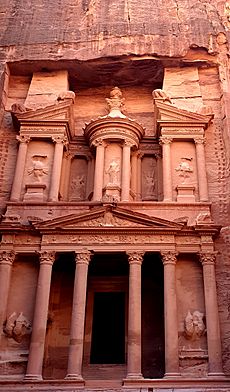
Petra was named a World Heritage Site by UNESCO on December 6, 1985. In 2007, it was also chosen as one of the New 7 Wonders of the World in a global poll. These honors highlight how important Petra is to the world.
The Petra Archaeological Park (PAP) was created in 2007 to manage and protect the site.
The Bedoul Bedouin, who used to live in Petra's caves, were moved to a new village called Umm Sayhoun in 1985. This was done to help protect the ancient site. The Bedoul's traditional skills and culture are recognized by UNESCO.
In 2011, a plan was created to guide Petra's development for the next 20 years. This plan aims to help the local people and Jordan while protecting Petra's unique heritage.
Petra faces several challenges. Ancient buildings can collapse, and floods can cause erosion. Salt from the rock can damage structures, and sometimes restorations are not done correctly. A big challenge is the increasing number of tourists. In 2019, Petra had 1.2 million visitors.
To help with these problems, the Petra National Trust (PNT) was started in 1989. It works with groups around the world to protect and preserve Petra. UNESCO and ICOMOS have also published books about threats to World Heritage sites, using Petra as a key example.
Petra is a special place where nature and culture meet. Since its rediscovery in 1812, it has attracted many people interested in the ancient Nabataean culture. Archaeologists have been studying Petra since the late 1800s. As more discoveries are made, it's important to protect them from the environment. Managing water is a big challenge, as it can damage the carved buildings.
Many projects have been done to protect Petra. These include:
- Restoring parts of the Treasury building in 1958.
- Working on the Temple of the Winged Lions from 1974 to 1990.
- Restoring the Qasr El Bint Temple in 1985.
- Excavating and preserving the Byzantine Church from 1990 to 1998.
- Restoring the Siq entrance to protect visitors and the path since 1996.
- Protecting ancient drainage systems to save the rock-cut buildings.
- Preserving wall paintings in Siq al Barid from 2006 to 2010.
- Ongoing efforts to preserve the Temple of the Winged Lions since 2009.
- A project from 2016 to 2019 to study and preserve paintings and sculptures.
Images for kids
See also
 In Spanish: Petra para niños
In Spanish: Petra para niños
- Hegra (Mada'in Salih)
- Bedul
- Incense Route – Desert Cities in the Negev
- List of colossal sculptures in situ
- List of modern names for biblical place names
- Ridge Church




